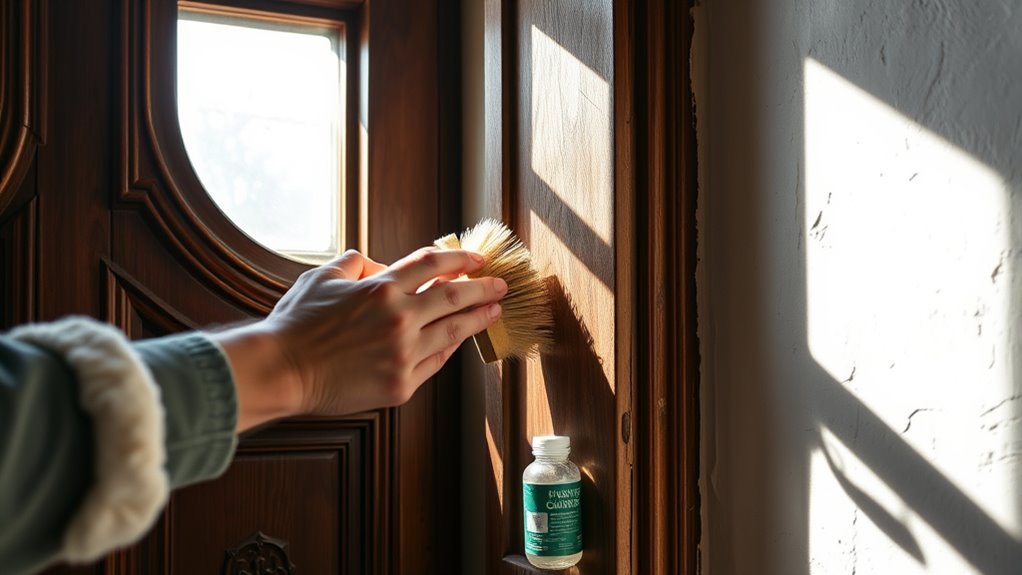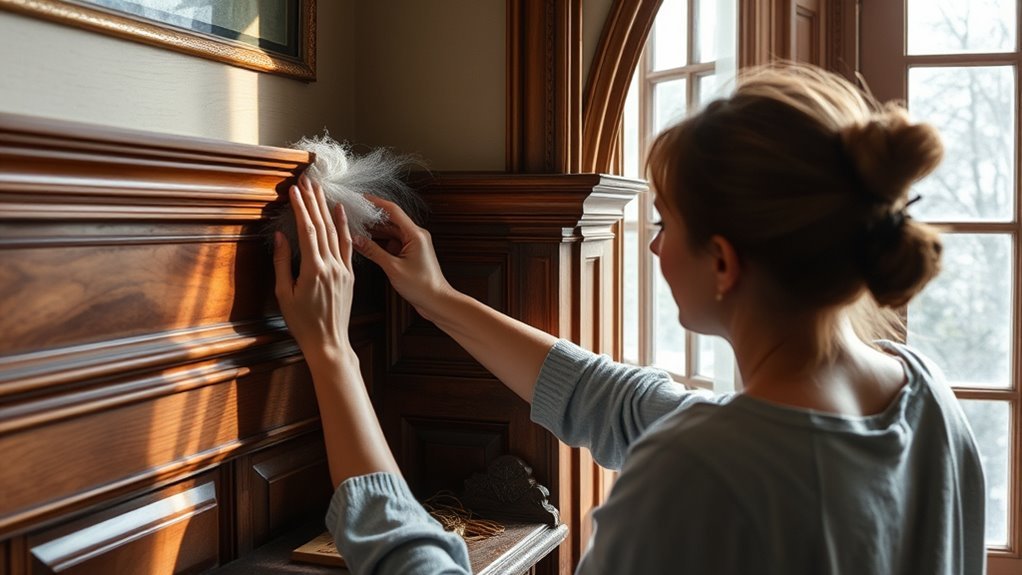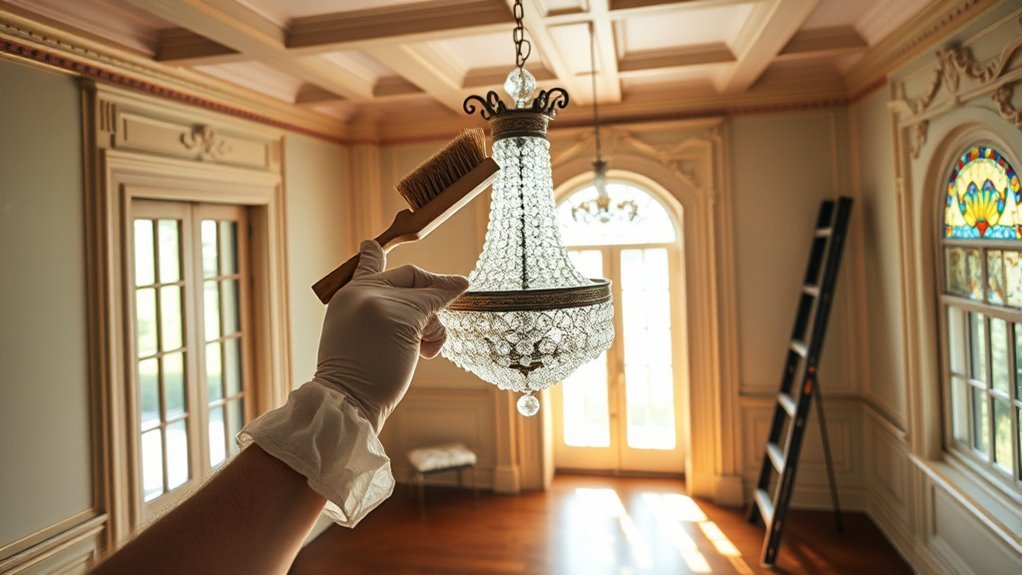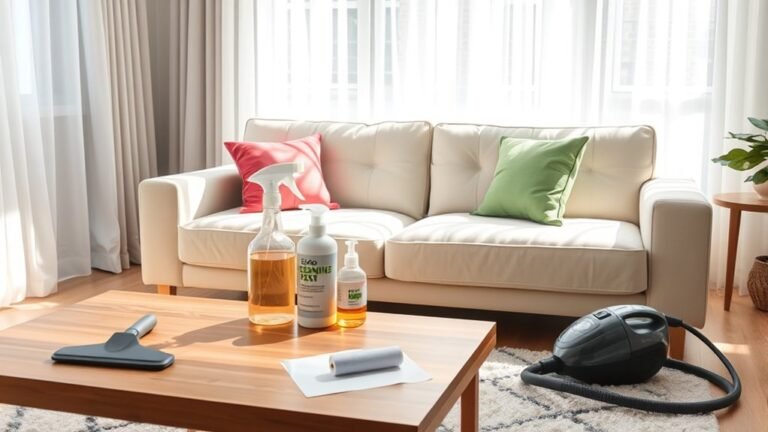Cleaning Historic Homes Without Damaging Features
You can clean your historic home gently by using mild, pH-neutral cleaners and soft tools like microfiber cloths or soft brushes. Avoid harsh chemicals and abrasive scrubbing, which can damage delicate wood, plaster, and vintage finishes. Regular light cleaning and inspecting for issues like moisture buildup help preserve your home’s charm and integrity. Taking these careful steps protects its unique character. Keep exploring for tips to maintain and enhance your home’s timeless beauty.
Understanding the Materials Used in Historic Homes

Before you begin cleaning a historic home, it is crucial to understand the materials used in its construction. Historic materials like aged wood, plaster, and lime-based mortar require special care to avoid damage. When you know what you’re dealing with, you can apply preservation techniques that protect these delicate surfaces while maintaining their character. You won’t want to use harsh scrubbing or modern chemicals that strip away patina or weaken the structure. Instead, embrace gentle methods tailored to each material’s needs, ensuring you preserve the home’s authenticity. Understanding these materials frees you from guesswork and lets you clean confidently, honoring the craftsmanship and history embedded in every corner of your cherished space.
Choosing the Right Cleaning Products for Antique Surfaces
When cleaning antique surfaces, you’ll want to choose products with gentle ingredients that won’t damage delicate materials. Harsh chemicals can cause permanent harm, so it’s best to avoid them altogether. Selecting the right cleaner helps preserve the beauty and integrity of your historic home.
Gentle Ingredients Matter
Since antique surfaces are often fragile, you’ll want to choose cleaning products with gentle ingredients that won’t cause damage. Opting for gentle cleaners lets you preserve delicate finishes while still keeping your historic home fresh. Eco friendly solutions are a smart choice—they protect both your cherished surfaces and the environment, giving you peace of mind. When selecting your cleaning products, look for these features:
- Biodegradable and non-toxic ingredients
- pH-neutral formulas to avoid surface wear
- Natural oils or mild detergents instead of synthetic chemicals
- Products free from harsh abrasives or bleach
Avoid Harsh Chemicals
Choosing cleaning products with gentle ingredients is a great start, but you also need to steer clear of harsh chemicals that can cause irreversible damage to antique surfaces. When caring for historic homes, you want to preserve their character, not strip it away. Instead, opt for eco friendly alternatives that clean effectively without compromising delicate finishes. Natural cleaners like vinegar, baking soda, and castile soap offer powerful yet safe options that respect your home’s history. Avoid bleach, ammonia, and abrasive solvents—they might provide a quick fix but can degrade wood, plaster, or paint over time. By choosing natural cleaners and eco friendly alternatives, you maintain the integrity of your historic home while embracing a cleaning routine that aligns with your values and desire for freedom from harmful chemicals.
Techniques for Cleaning Delicate Woodwork and Trim

Although delicate woodwork and trim add charm to historic homes, they require careful cleaning to avoid damage. When you’re tackling wood finish restoration, start gently with proper dust removal techniques to preserve the surface. Use soft cloths or natural bristle brushes to avoid scratching. Avoid soaking the wood; instead, lightly dampen your cloth with a mild, pH-neutral cleaner. Remember, patience is key—rushing can harm the finish.
Here’s how to protect your woodwork:
- Use microfiber cloths for dusting
- Test cleaning solutions on hidden spots
- Avoid abrasive tools or harsh chemicals
- Apply a quality wood conditioner after cleaning
Safely Removing Dirt and Grime From Plaster Walls
When cleaning plaster walls, you’ll want to use gentle cleaning solutions to avoid damage. A soft bristle brush helps lift dirt without scratching the surface. Always perform a spot test first to make sure your method won’t harm the plaster.
Gentle Cleaning Solutions
To safely remove dirt and grime from plaster walls, you’ll want to use gentle cleaning solutions that won’t damage the delicate surface. Choosing eco friendly options is key, as they offer safe alternatives to harsh chemicals, preserving both your historic home and the environment. You can enjoy the freedom of maintaining your walls without worry by considering these solutions:
- Mild dish soap mixed with warm water
- White vinegar diluted in water for natural disinfecting
- Baking soda paste for spot cleaning stubborn stains
- Commercial eco friendly cleaners designed for delicate surfaces
Always test your chosen solution on a small, hidden area first. This approach lets you clean effectively while respecting the unique character of your historic plaster walls, keeping them beautiful for years to come.
Soft Bristle Brushes
Since plaster walls are delicate, using soft bristle brushes is one of the safest ways to remove dirt and grime without causing damage. When choosing brush types, opt for natural or synthetic soft bristles that won’t scratch or wear down the surface. You’ll find soft bristle uses vary—from dusting corners to gently scrubbing textured areas where dirt settles. By selecting the right brush, you maintain your home’s historic charm without sacrificing its integrity. Avoid stiff or harsh bristles that can chip or erode plaster. Instead, let a soft bristle brush be your go-to tool for freeing your walls from grime while preserving their original beauty. This simple choice gives you the freedom to clean thoroughly and carefully, respecting your home’s past.
Spot Test Procedures
Although cleaning historic plaster walls can be delicate work, you can avoid damage by performing spot tests before applying any cleaning solution. Spot test procedures guarantee the surface compatibility of your chosen cleaner and reveal any adverse reactions. To carry out effective testing methods, follow these steps:
- Select a small, inconspicuous area on the plaster wall.
- Apply the cleaning solution sparingly and wait a few minutes.
- Observe for discoloration, texture changes, or surface damage.
- Rinse the test area gently and let it dry completely.
Maintaining Vintage Fixtures and Hardware
When caring for vintage fixtures and hardware, you’ll want to handle them gently to preserve their unique character. Avoid harsh chemicals that can strip finishes or cause corrosion. Instead, opt for mild soaps and soft cloths to clean surfaces, guaranteeing you don’t damage delicate patinas. Regular vintage restoration efforts, like polishing brass or tightening loose screws, help maintain both function and charm. Remember, hardware preservation means respecting original materials; if replacements are necessary, choose period-appropriate pieces to keep authenticity intact. By taking these careful steps, you’ll protect the history embedded in your fixtures while enjoying the freedom to live comfortably in your historic home. This mindful approach guarantees your vintage treasures remain beautiful and functional for years to come.
Dealing With Mold and Mildew Without Harsh Chemicals

If you want to protect your historic home while tackling mold and mildew, you’ll need to avoid harsh chemicals that can damage delicate materials. Instead, opt for gentle, effective methods that respect your home’s character. For mold removal and mildew prevention, try these natural approaches:
- Use a vinegar solution to kill mold spores without harming surfaces.
- Apply baking soda paste for scrubbing affected areas gently.
- Increase ventilation to reduce moisture buildup, a key factor in mildew growth.
- Use essential oils like tea tree oil for their antifungal properties.
These methods help you maintain your home’s integrity while effectively managing mold and mildew. By choosing natural solutions, you keep your historic features safe and enjoy the freedom of a healthy, chemical-free environment.
Preventative Care to Preserve Historic Features
Since historic features are often fragile and irreplaceable, you’ll want to adopt preventative care strategies that minimize wear and damage over time. Preventative maintenance is key—you can’t afford to wait for problems to appear. Set up a schedule for routine inspections to catch issues early, whether it’s wood rot, peeling paint, or moisture buildup. By regularly checking your home’s unique details, you maintain control over its condition and avoid costly repairs later. Remember, preserving freedom in how you care for your home means being proactive and attentive without relying on harsh chemicals or invasive methods. Taking these simple steps lets you enjoy your historic home’s charm while protecting its legacy for years to come.
Frequently Asked Questions
How Often Should Historic Homes Be Professionally Inspected for Structural Issues?
You should aim for an inspection frequency of at least every 3 to 5 years to keep your historic home’s structural maintenance on track. This regular check helps catch issues early, letting you enjoy your freedom without worrying about costly repairs later. Of course, if you notice any signs of trouble, like cracks or sagging, don’t wait—get a professional inspection sooner to protect your treasured home’s integrity.
Can Modern Cleaning Tools Damage Historic Stained Glass Windows?
You might think modern cleaning tools make stained glass preservation easier, but they can actually cause damage if you’re not careful. Abrasive brushes or harsh chemicals might scratch or weaken the glass and lead cames. To keep your windows safe, always check cleaning product safety and opt for gentle, non-abrasive solutions. That way, you’ll maintain the beauty and freedom of your historic stained glass without risking harm.
What Is the Best Way to Clean Vintage Wallpaper Without Peeling It?
When caring for vintage wallpaper, you’ll want to be gentle to avoid peeling. Start with a soft, dry cloth or a vacuum using a brush attachment to remove dust. For spot cleaning, mix mild cleaning solutions like diluted dish soap and water. Test a small hidden area first to guarantee it won’t damage the paper. Avoid saturating the wallpaper—lightly dab and let it air dry. This way, you preserve its charm while keeping it fresh.
Are There Specific Times of Year Best for Cleaning Historic Homes?
You might think cleaning historic homes demands a cosmic event—like aligning the stars! But really, spring cleaning is your golden ticket. It’s the perfect time for seasonal maintenance, when nature’s rebirth inspires fresh energy. You’ll want to tackle dust and grime before humidity or winter chills set in, preserving your home’s charm without stress. So, embrace spring’s freedom to refresh, keeping your treasured space vibrant all year long.
How Do You Handle Pest Control Without Harming Antique Features?
You’ll want to focus on pest prevention techniques that respect antique preservation. Avoid harsh chemicals that could harm delicate materials; instead, use natural deterrents like essential oils or diatomaceous earth. Keep your space well-ventilated and dry to discourage pests naturally. Regular inspections catch problems early, letting you act without invasive treatments. This way, you protect both your freedom to enjoy the home and its timeless features without damage.






